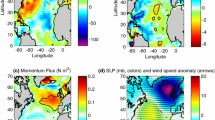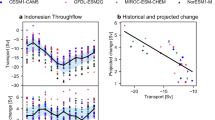Abstract
The annual mean volume and heat transport sketches through the inter-basin passages and transoceanic sections have been constructed based on 1 400-year spin up results of the MOM4p1. The spin up starts from a state of rest, driven by the monthly climatological mean force from the NOAA World Ocean Atlas (1994). The volume transport sketch reveals the northward transport throughout the Pacific and southward transport at all latitudes in the Atlantic. The annual mean strength of the Pacific-Arctic-Atlantic through flow is 0.63×106 m3/s in the Bering Strait. The majority of the northward volume transport in the southern Pacific turns into the Indonesian through flow (ITF) and joins the Indian Ocean equatorial current, which subsequently flows out southward from the Mozambique Channel, with its majority superimposed on the Antarctic Circumpolar Current (ACC). This anti-cyclonic circulation around Australia has a strength of 11×106 m3/s according to the model-produced result. The atmospheric fresh water transport, known as P-E+R (precipitation minus evaporation plus runoff), constructs a complement to the horizontal volume transport of the ocean. The annual mean heat transport sketch exhibits a northward heat transport in the Atlantic and poleward heat transport in the global ocean. The surface heat flux acts as a complement to the horizontal heat transport of the ocean. The climatological volume transports describe the most important features through the inter-basin passages and in the associated basins, including: the positive P-E+R in the Arctic substantially strengthening the East Greenland Current in summer; semiannual variability of the volume transport in the Drake Passage and the southern Atlantic-Indian Ocean passage; and annual transport variability of the ITF intensifying in the boreal summer. The climatological heat transports show heat storage in July and heat deficit in January in the Arctic; heat storage in January and heat deficit in July in the Antarctic circumpolar current regime (ACCR); and intensified heat transport of the ITF in July. The volume transport of the ITF is synchronous with the volume transport through the southern Indo-Pacific sections, but the year-long southward heat transport of the ITF is out of phase with the heat transport through the equatorial Pacific, which is northward before May and southward after May. This clarifies the majority of the ITF originating from the southern Pacific Ocean.
Similar content being viewed by others
References
Broecker W S. 1991. The great ocean conveyor. Oceanography, 4(2): 79–89
Bryan F. 1986. High-latitude salinity effects and interhemispheric thermohaline circulations. Nature, 323(6086): 301–304
Coachman L K, Aagaard K. 1988. Transports through Bering Strait: Annual and interannual variability. J Geophys Res, 93(C12): 15535–15539
England M H, Huang Fei. 2005. On the interannual variability of the Indonesian Throughflow and its linkage with ENSO. J Climate, 18(9): 1435–1444
Ganachaud A, Wunsch C. 2003. Large-scale ocean heat and freshwater transports during the World Ocean Circulation Experiment. J Climate, 16(4): 696–705
Godfrey J S, Golding T J. 1981. The Sverdrup relation in the Indian Ocean, and the effect of Pacific-Indian Ocean Throughflow on Indian Ocean circulation and on the East Australian Current. J Phys Oceanogr, 11(6): 771–779
Godfrey J S, Wilkin J, Hirst A C. 1993. Why does the Indonesian Throughflow appear to originate from the North Pacific?. J Phys Oceanogr, 23(6): 1087–1098
Gordon A L. 1986. Interocean exchange of thermocline water. J Geophys Res, 91(C4): 5037–5046
Gordon A L, Fine R A. 1996. Pathways of water between the Pacific and Indian Oceans in the Indonesian seas. Nature, 379(6561): 146–149
Gordon A L, Sprintall J, Van Aken H M, et al. 2010. The Indonesian Throughflow during 2004–2006 as observed by the INSTANT program. Dynamics of Atmospheres and Oceans, 50(2): 115–128
Griffies S M. 2010. Elements of Mom4p1. GFDL Ocean Group Technical Report, No. 6
Hellerman S, Rosenstein M. 1983. Normal monthly wind stress over the world ocean with error estimates. J Phys Oceanogr, 13(7): 1093–1104
International Arctic Science Committee. 2012. Precipitation and evapotranspiration in the Arctic. The Encyclopedia of the Earth, Section 6. 2. Topic Editor: Sidney Draggan
Macdonald A M, Wunsch C. 1996. An estimate of global ocean circulation and heat fluxes. Nature, 382(6590): 436–439
Marotzke J, Willebrand J. 1991. Multiple equilibria of the global thermohaline circulation. J Phys Oceanogr, 21(9): 1372–1385
Metzger E J, Hurlburt H E, Xu X, et al. 2010. Simulated and observed circulation in the Indonesian Seas: 1/12° global HYCOM and the INSTANT observations. Dynamics of Atmospheres and Oceans, 50(2): 275–300
Meyers G, Bailey R J, Worby A P. 1995. Geostrophic transport of Indonesian Throughflow. Deep-Sea Res, 42(7): 1163–1174
Murray S P, Arief D. 1988. Throughflow into the Indian Ocean through the Lombok Strait, January 1985–January 1986. Nature, 333(6172): 444–447
Schmitz W J Jr. 1995. On the interbasin-scale thermohaline circulation. Rev Geophys, 33(2): 151–173
Stammer D, Wunsch C, Giering R, et al. 2003. Volume, heat, and freshwater transports of the global ocean circulation 1993–2000, estimated from a general circulation model constrained by World Ocean Circulation Experiment (WOCE) data. J Geophys Res, 108(C1): 7-1–7-23
Stammer D, Ueyoshi K, Köhl A, et al. 2004. Estimating air-sea fluxes of heat, freshwater, and momentum through global ocean data assimilation. J Geophys Res, 109(C5): C05023
Stockdale T, Anderson D, Davey M. et al. 1993. Intercomparison of tropical Pacific ocean GCMs. WCRP79, WMO/TD-545, World Meteorological Organization, Geneva, 96pp
Sui Cuijuan, Zhang Zhanhai, Liu Jiping, et al. 2008. Variation of Arctic runoff and its association with climate factors. Acta Oceanologica Sinica (in Chinese), 30(4): 39–47
Wang Yonggang, Fang Guohong, Wei Zexun, et al. 2004. Seasonal variability of the Indonesian throughflow from a variable-grid global ocean model. Journal of Hydrodynamics, Ser B, 16(5): 525–532
Wijffels S E, Schmitt R W, Bryden H L, et al. 1992. Transport of freshwater by the oceans. J Phys Oceanogr, 22(2): 155–162
Wijffels S E. 2001. Ocean transport of fresh water. In: Siedler G, Church J, Gould J, eds. Ocean Circulation and Climate. San Diego: Academic Press, 475–488
Woodgate R A, Aagaard K. 2005. Revising the Bering Strait freshwater flux into the Arctic Ocean. Geophys Res Lett, 32(2): L02602
Woodgate R A, Aagaard K, Weingartner T J. 2005. Monthly temperature, salinity, and transport variability of the Bering Strait through flow. Geophys Res Lett, 32(4): L04601
Wyrtki K. 1961. Scientific Results of Marine investigations of the South China Sea and the Gulf of Thailand 1959–1961. Scripps Institute of Oceanography, Technical Report, NAGA Report-Volume 2: 195
Wyrtki K. 1987. Indonesian through flow and the associated pressure gradient. J Geophys Res, 92(C12): 12941–12946
Zhu Yaohua, Wei Zexun, Fang Guohong, et al. 2014. Interbasin exchanges and their roles in global ocean circulation: A study based on 1400 years’ spin up of MOM4p1. Acta Oceanologica Sinica, 33(1): 11–23
Author information
Authors and Affiliations
Corresponding author
Additional information
Foundation item: The National Basic Research Program Grant of China under contract No. 2011CB403502; the National High Technology Research and Development Program (863 Program) under contract No. 2013AA09A506; the Global Change and Air-Sea Interaction Program under contract No. GASI-03-01-01-04; the International Cooperation Program Grant of China under contract No. 2010DFB23580; author Guan Yuping is supported by the National Natural Science Foundation of China under contract Nos 40976011 and 91228202.
Rights and permissions
About this article
Cite this article
Zhu, Y., Wei, Z., Wang, Y. et al. The annual mean sketches and climatological variability of the volume and heat transports through the inter-basin passages: A study based on 1 400-year spin up of MOM4p1. Acta Oceanol. Sin. 33, 12–24 (2014). https://doi.org/10.1007/s13131-014-0513-7
Received:
Accepted:
Published:
Issue Date:
DOI: https://doi.org/10.1007/s13131-014-0513-7




